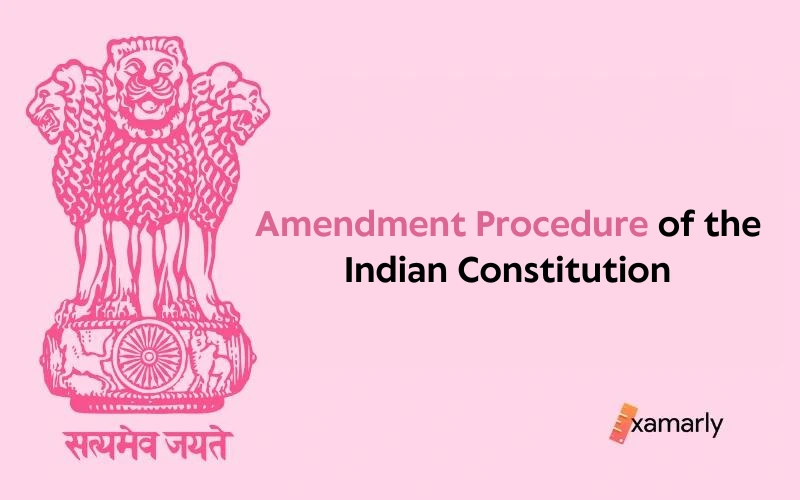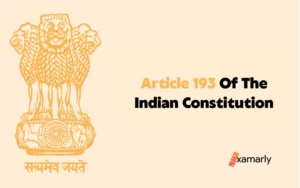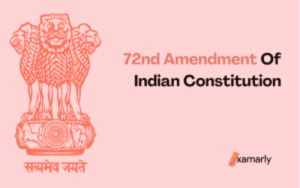Do you want to know more about the Amendment procedure of the Indian constitution?
The constitution of the nation, considered to be the people’s common will, serves as the foundational rule of law, from which all other laws are derived and preserved.
The Constitution Amendment of India entails changing the fundamental or fundamental law of the country that establishes the government’s main organs-executive, legislature, and judiciary.
The Constitution declares India to be an independent, democratic socialist republic, promising order, dignity, and freedom for its people, this was approved on 26 November 1949 by India’s Constituent Assembly and came into force on 26 January 1950.
This article discusses the process for amending the Indian Constitution. Read this article ahead to decode the reason behind the need for the procedure, how the constitution is amended, its limitations, and many more useful pieces of information.
This article will be beneficial for the UPSC aspirants preparing for IAS Exam. The amendment procedure of the Indian Constitution is a part of the Indian Polity of UPSC Syllabus.
- Amendments: Indian Constitution
- Guidelines for Amending the Indian Constitution
- Role of State Legislature
- Role of Union Territories
- What is the Need for Amendment Procedure of the Constitution?
- The Process for Modifying the Indian Constitution – Constitutional Guidelines
- Procedures to Amend the Indian Constitution
- Parliamentary Simple Majority
- Parliamentary Special Majority
- Special Majority in the Parliament and State Consent
- Formal and Informal Mode of Amendment
- Features
- Basic structure
- The Extent of the Changes Made to the Indian Constitution Through Amendments
- Parts frequently amended in Indian Constitution
- Limitations
- Criticism
- Conclusion
- Frequently Asked Questions
- How is the Indian Constitution amended?
- How many times has the Indian Constitution been amended?
- What are the basic features of the Indian Constitution that cannot be amended?
- Who has the power to amend the Indian Constitution?
- Can the Indian Constitution be amended without the consent of the states?
- What is the role of the President in the amendment procedure of the Indian Constitution?
- What is the difference between a formal and informal amendment to the Indian Constitution?
- What is the significance of the 42nd Amendment to the Indian Constitution?
- Can the Indian Constitution be amended to remove or alter fundamental rights?
- What is the time limit for ratification of a Constitutional Amendment in India?
Amendments: Indian Constitution
Amendments to the Indian Constitution refer to changes in the Constitution of India. Constitutions and statutes that already exist can be amended.
The Indian legislature is in charge of creating new laws, changing those that already exist, and, in certain circumstances, repealing those that are no longer necessary.
These changes include devolution from the state to the centre, the removal of princely states’ titles and the increasing strength and reach of the Lok Sabha (from 525 to 555).
Giving Parliament supremacy over the states, and defining the role and responsibilities of the state government, and the Prime Minister.
Guidelines for Amending the Indian Constitution
The Indian Constitution’s Part XX (Article 368) details the process for amending the Constitution. The Amendment procedure of the Indian Constitution is a legislative process that can be described as a partly flexible and partly rigid method.
A provision may be amended under Article 368 of the Constitution, but its basic features cannot. Each provision’s significance will determine how the amendment process works.
The Indian Constitution can be amended by a bill being introduced in either House of Parliament. However, the Constitution doesn’t allow for a bill to be introduced in any state legislature.
The amended bill must gain a special and absolute majority by the two houses of Parliament before becoming law.
In case of any disagreement, there is no provision for a joint session of the houses. It can either be an addition, a variation, or an omission. Some amendments can be made by a simple majority under the Indian Constitution.
Article 368 requires a majority of two-thirds of the members present to vote in both Houses. This majority is known as the Effective Majority.
Before an amendment bill is approved, it must first be ratified by at least half the state’s legislatures. However, some articles of the Constitution require a special majority of representatives from the House.
According to law amendments, most constitutions require that amendments go through a special procedure to enter into force. Compared to the standard Ordinary legislation, this one is more stringent.
A supermajority in parliament or direct voter approval in a referendum are two of the most significant instances of such processes.
Role of State Legislature
The state’s participation in the constitutional amendment is restricted. State legislatures are not permitted to introduce bills or proposals for constitutional amendments.
If the amendment seeks to alter any of the conditions listed in the proviso to article 368, they are solely involved in the ratification process described in that article’s article 368.
The only other way for state legislatures to bring about constitutional changes is by initiating the creation or dissolution of Legislative Councils in their respective assemblies.
Additionally, they can also provide feedback on any proposed Parliamentary measure seeking to amend the area, boundaries, or name of any State or States, which is referred to them under the proviso to Article 3.
Role of Union Territories
Union territories are not allowed to take part in the ratification process for constitutional amendments, as this process is only applicable to states.
Three union territories have acquired special provisions that grant them a certain amount of limited statehood and allow them to elect their Legislative Assembly and their Cabinet of Ministers. These three Union territories are Puducherry, Delhi, Jammu and Kashmir.
What is the Need for Amendment Procedure of the Constitution?
Provisions for modifying the constitution are included in every constitution in the world. A constitution must grow to be alive. The following justifies why amendment provisions are necessary for any constitution:
- The operation of the constitution may reveal specific challenges that must be solved for the constitution to function properly.
- An inflexible constitution may grow obsolete and lose its societal significance. Furthermore, if the constitution is too stiff, it won’t be feasible to change it. These situations would be yet another justification for using extraconstitutional techniques that might undermine the integrity of the country.
- The constitution must be dynamic to keep up with society’s evolving needs. As society expands, the constitution must change to meet new requirements.
- Being a social constitution, the Indian Constitution is dedicated to fostering social development and has several social goals. As a result, the constitution must adjust to the societal changes that result from the constitution itself.
- In the lack of an amendment procedure, the necessity for modification in constitutional provisions would be challenging. The social structure could be negatively impacted by revolutionary changes that result from it.
The Process for Modifying the Indian Constitution – Constitutional Guidelines
- To alter the constitution, a private member’s bill or ministerial bill must be presented. The consent of the president is not necessary. It is practicable in any home. It requires both a majority (i.e., more than 50%) of the House’s total membership and a special majority of two-thirds of the members of the House present and voting.
- The other house follows a similar process before referring a measure to the president for approval. It needs the President’s required approval.
- Before being submitted to the president for assent, an amendment that modifies the federal provisions of the constitution must get a simple majority of state legislatures’ approval. The Constitution cannot be changed by an ordinance. Additionally, there is no option for a joint sitting in the event of a dispute.
Procedures to Amend the Indian Constitution
Different types of amendments are possible. Some require greater consensus. Others only require a simple majority from the legislatures of the states to pass changes. However, the judiciary retains the final decision-making authority in this matter.
The Constitution may be altered in three different ways, namely,
- Amendment by simple majority
- Amendment by special majority
- Amendment by a special majority with ratification by the state legislature.
Parliamentary Simple Majority
The Indian Constitution allows for the modification of certain clauses with a simple majority or more than 50% of those present and voting.
This type of majority is used in several cases such as Article 5 – Citizenship, Article 169 – the establishment of the legislative council, Delimitation of constituencies, English-Language Provisions, Number of puisne judges in the supreme court, Provisions governing the exercise of the executive authority, Rules of procedure in Parliament, 5th and 6th schedule and Article 239A – the establishment of municipal legislatures or council of ministers.
Parliamentary Special Majority
More than 50% of the entire membership and two-thirds of those in attendance and voting constitute a noteworthy majority. 545 Lok Sabha and 245 Rajya Sabha members make up each House.
The Directive Principles of State Policy, the Fundamental Rights, and any other provisions not covered by the other two groups are subject to change by the special majority.
Special Majority in the Parliament and State Consent
A special majority of the Indian Parliament and consent from half of the states can change all sections of the Indian Constitution that deal with the federal system of governance, no matter whether one or some remaining states take no action on the bill.
Among the Constitutional provisions are the executive and legislative power of the Union and the State, the lists in the seventh schedule, Representation of the State in the Parliament, the High Court for Union Territories, and Provisions dealing with the amendment of the Constitution which may be amended only by a rigid method.
Formal and Informal Mode of Amendment
Informal Mode
The language of the statute remains unchanged using this approach. It doesn’t change. The understanding and meaning of it are altered.
For instance, there are numerous modifications to Article 21. However, it alters the context, extent, and ambit of Article 21. But it never alters the content.
The entitlement to life encompasses the availability of unpolluted air, education, healthcare, as well as prompt and equitable legal proceedings.” Many other things are all part of the right to life.
Formal Mode
This type of amendment modifies the wording or words of the statute. The clause is altered through addition, modification, or omission. For instance, the Preamble was amended to include several phrases.
The phrases were Secular, Socialist, and Integrity. It was done by the 42nd amendment of 1976. The Preamble was included as part of this revision. The changes are also made through omission or modification.
Features
- Our constitution gives Parliament, the Union’s regular legislative body, the right to make constitutional amendments; unlike some other nations, ours does not have a distinct body for this purpose.
- Only the Parliament, not the State Legislature, may introduce a bill for the change of the Constitution.
- No previous approval from the President is necessary to present a measure amending the constitution in the parliament.
- It must be approved individually by both Houses of Parliament. In its final form, a constitutional amendment measure is forwarded to the President for approval, and he is not allowed to object.
- The 24th Amendment Act of 1971 replaced the phrase “shall have the power to withhold his assent” in Clause (2) of Article 368 with the phrase “shall give his assent,” thereby eliminating the President’s authority to reject a proposed constitutional amendment.
- However, there is no deadline by which the President must provide his assent.
- In the Keshavnanda Bharati case, the Supreme Court determined that parliament cannot alter the “Basic structure” of the constitution.
Basic structure
The Indian Constitution’s basic structure is a set of fundamental rights and freedoms that govern the state’s functioning.
It includes the sovereign democratic republic, a parliamentary system, separation of power, three organs of government, and the power of the judiciary.
The Supreme Court has the authority over all constitutional amendments. In various cases, its interpretations of the Constitution have been challenged.
For instance, the validity of the 25th Amendment act was challenged along with the 24th and 29th Amendments, but the court ruled on both cases.
The court had already dismissed the Golak-Nath case, in which parliament had been denied the power, and the Kesavananda Bharati case, which found that the Constitution grants parliament the power, to overturn the validity of the 25th Amendment act.
Although the Supreme Court’s judicial review is an important part of Indian polity, it does not have absolute powers.
Relatable Article:
- 24th Amendment Of the Indian Constitution
- 25th Amendment Of the Indian Constitution
- 29th Amendment Of the Indian Constitution
- Tricks To Remember Amendments Of the Indian Constitution
- Powers And Functions Of Lok Sabha and Rajya Sabha
The Extent of the Changes Made to the Indian Constitution Through Amendments
The Indian Constitution has a wide range in terms of its amenability. However, it is not an absolute right. The Parliament has the power to amend the Constitution, but the courts can review the constitutional validity and validity of any law passed by them.
The courts can also change the wording of the law if they believe it is unconstitutional.
The Fundamental Rights case is a key case that illustrates the extent of the Constitution’s power to amend it. In this case, a politically active challenged the Constitutional Amendment Acts 25th and 24th, which declared that Parliament was empowered to reduce Fundamental Rights.
These decisions were overturned by the Supreme Court, which ruled that Parliament could amend the Constitution, but not remove it.
Moreover, the scope of amenability is narrower than one might think. The Constitution’s enumerated powers are different from the constituent powers. The constituent power declares its ability to define its competencies within the framework of the constitution.
Parts frequently amended in Indian Constitution
Many provisions are included in the Indian Constitution that allows amendments or modifications to be made.
- Fundamental Rights-The restriction of the Fundamental Rights charter is the most significant and common justification for Constitutional modifications. This is accomplished by adding laws that violate the Constitution’s guarantees of fundamental rights to Schedule 9 of the document. Such statutes are shielded from judicial review by Schedule 9. Typically, the limitations placed are on regulations about ownership of assets and policies promoting the advancement of marginalised groups such as the “scheduled castes,” “scheduled tribes,” other “backward classes,” and individuals from lower socioeconomic backgrounds.
- Territorial adjustments–The Republic of India’s territorial boundaries has changed. It was a result of the integration of the former French colony of Pondicherry, the former Portuguese colony of Goa, and a modest exchange of land with Pakistan. This has been made possible by constitutional revisions. Amendments are also required for the formation of new states and union territories. It was through the restructuring of existing states, as well as for littoral rights over the 200-mile exclusive economic zone. Article 368 of the Constitution’s revision provides for the peaceful division of the nation as long as Article 13’s fundamental rights are upheld in each of the new nations. For example, through the Ninth Amendment Act of 1960, the former territory of Pakistan was granted to India.
- Provisions for transition-The constitution contain temporary clauses that are only meant to be in effect for a short time. Periodically, these need to be renewed. For instance, a constitutional amendment is passed. It is passed once every ten years to maintain caste and tribe reservations within parliamentary seats.
- Democratic reform-In order to modernize the political system. It adds new “checks and balances” to the Constitution, and amendments have been enacted.
Limitations
Limitations of amendments to the Indian Constitution are a set governing the scope for amendments.
These restrictions came about during the conflict between the Supreme Court and Parliament over the power to amend the Constitution. The Court then established different doctrines, including the Basic structure doctrine.
Although the Indian Constitution didn’t limit constitutional amendments, a Supreme Court case recently ruled that constitutional amendments cannot alter fundamental rights.
The constitutional amendment must fall under Article 368, which forbids it from reducing fundamental freedoms. However, the Court held that a constitutional amendment cannot change the fundamental right of an individual.
The Constitution restricts the power of the Parliament to amend the Indian Constitution.
While parliament is authorized to amend the Constitution, it cannot alter its fundamental values of equality and justice. These values can be protected by the functioning and vigilance in the political process and public opinion.
Criticism
- Amendment proposals cannot be made by states. It is possible to amend some parts of the legislation using the established legislative processes. States have unlimited time to pass the legislation.
- This approach leaves a lot of room for judicial scrutiny because of the confusing amendment procedure of the Indian Constitution.
- Only half of the states must be consulted when making changes to the federal structure.
Conclusion
The Indian Constitution was designed as a dynamic statute that addresses the demands of the various social strata in Indian society while also remaining viable throughout time without becoming outdated.
It was written taking into account the best features of other constitutions in the mind. The guiding premise for preserving these ideals and the Constitution’s core is the doctrine of the Basic Structure, which was put forth by the Honorable Supreme Court.
The foundation of modern democracy is the constitution that could be torn apart by misuse leading to an overabundance of legislative or executive power.
Frequently Asked Questions
How is the Indian Constitution amended?
The procedure for amending the Indian Constitution is laid out in Article 368, which requires a bill to be introduced in either house of Parliament and passed with a two-thirds majority.
How many times has the Indian Constitution been amended?
The Indian Constitution has been amended 104 times since its adoption in 1950.
What are the basic features of the Indian Constitution that cannot be amended?
The basic features of the Indian Constitution that cannot be amended include the federal structure, secularism, democratic principles, and fundamental rights.
Who has the power to amend the Indian Constitution?
The power to amend the Indian Constitution lies with the Parliament of India, specifically the Lok Sabha and Rajya Sabha.
Can the Indian Constitution be amended without the consent of the states?
No, the Indian Constitution cannot be amended without the consent of at least half of the state legislatures.
What is the role of the President in the amendment procedure of the Indian Constitution?
The President plays a limited role in the amendment procedure of the Indian Constitution, as they must give their assent to the amendment bill once it has been passed by Parliament.
What is the difference between a formal and informal amendment to the Indian Constitution?
A formal amendment to the Indian Constitution is a deliberate change made through the official amendment procedure outlined in Article 368, while an informal amendment refers to changes made through judicial interpretation or political practice.
What is the significance of the 42nd Amendment to the Indian Constitution?
The 42nd Amendment to the Indian Constitution, passed in 1976, was significant because it strengthened the power of the central government and limited the power of the judiciary.
Can the Indian Constitution be amended to remove or alter fundamental rights?
Yes, the Indian Constitution can be amended to remove or alter fundamental rights, although certain basic features of the Constitution cannot be altered.
What is the time limit for ratification of a Constitutional Amendment in India?
There is no time limit for ratification of a Constitutional Amendment in India, although the process must be completed within a reasonable period of time.






